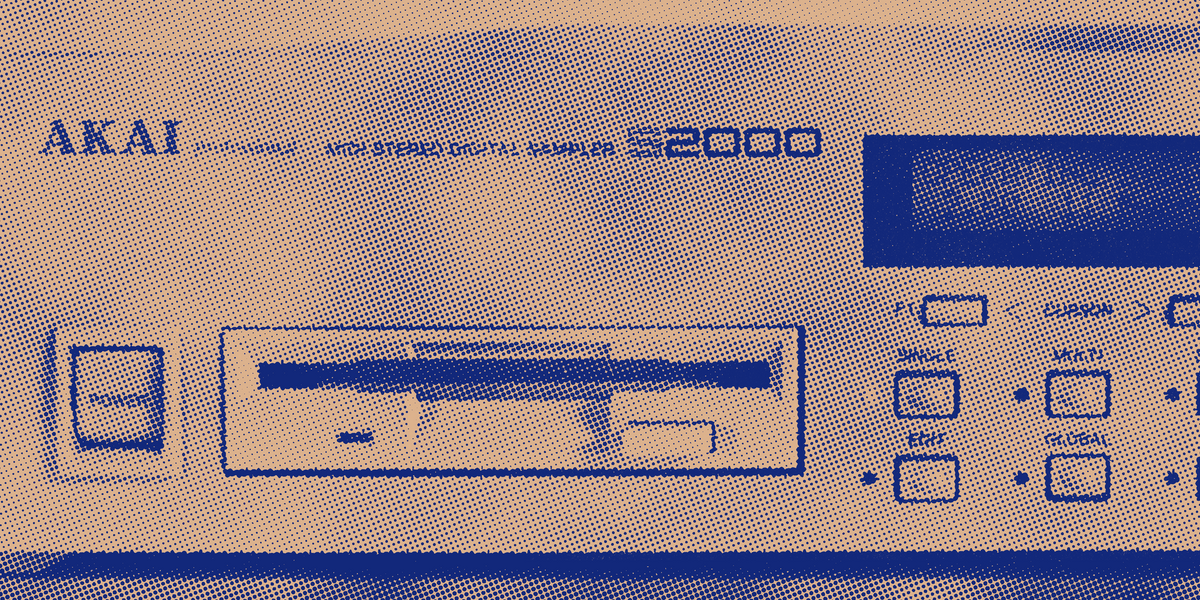Revisiting the nostalgia (and PTSD) of the Akai S2000 sampler
The Akai S2000 became the default sampler and a studio workhorse for an entire generation (who endured that tiny little screen and lived to tell the tale).

This one is a hard and weird and fun one to write about because it was my very first sampler. I loved it. I hated it. I used it. I ignored it. It came to gigs before I could afford an MPC sampler in the 1990s, and then it lived in a rackmount until I finally realised... life is too short for that tiny little screen and the endless encoder knob twirling. Not quite modern enough to be easy to use, not old enough to have any nostlagia around the previous generation's low bit rates, the S2000 was... realiable and useful and about as vanilla as can be. But it's important to recognise, so let's jump right in.
Historical Context
In the 1990s, the music industry was still dominated by hardware. But it wasn't always easy to get a hold of let alone afford. Those "found a 303 in a second hand store for ten bucks" tales were already becoming mythology. The rise of the internet towards the late 1990s played a major role in how music was becoming more readily available globally, and started to set up a butterfly effect for musicians and the wider industry.
In terms of music technology, the 1990s saw the use of various samplers. One of the first samplers to truly change the face of modern music was E-Mu Systems' SP-12 (and the more popular SP1200), which was released in 1985. Other notable samplers of the time included the Fairlight CMI, which was considered to be the first (relatively) affordable commercially available sampler. The use of samplers was not limited to a specific genre. For instance, in 1990, the London-based duo Shut Up and Dance released "Lamborghini," a track that combined the four-on-the-floor beat of acid house with a sample of The Eurythmics' "Sweet Dreams" and some choice reggae-style toasting from British reggae duo The Ragga Twins.
Development and Release
The Akai S2000, a professional and user-expandable studio sampler, was released in the mid-1990s, offering astonishing value for its price. The base model came with 2MB of sample memory, which could be expanded to 32MB. The sampling specifications were variable, with sample rates ranging from 22kHz to 44.1kHz in stereo or mono and at 16- or 8-bit resolution.
The S2000 was part of Akai's S series samplers, which had become fixtures in studios worldwide due to their powerful features and user-friendly interfaces. The S2000 continued this legacy, offering a low-cost option for musicians and producers without compromising on the quality and versatility that Akai samplers were known for. The release of the S2000 was a significant event in the music industry, as it made sampling technology more accessible to a wider range of artists and producers. This democratization of technology played a crucial role in shaping the music of the era and beyond.
Technical Specifications
The Akai S2000 is a professional and user-expandable studio sampler. The base model comes with 2MB of sample memory, which can be expanded to 32MB. This flexibility in memory expansion allowed users to adapt the sampler to their specific needs, making it a versatile tool for music production.
The S2000 offered variable sampling specifications, with sample rates ranging from 22kHz to 44.1kHz in stereo or mono and at 16- or 8-bit resolutions. This range of sample rates and resolutions provided users with a wide array of options for sound quality and memory usage, enabling them to strike the right balance based on their project requirements.
The S2000 was a 16-bit sampler, capable of mono or stereo sampling. This technical feature allowed for high-quality sound reproduction, which was a key factor in the S2000's popularity among musicians and producers. It's rack mount was an easy 2-space rack unit, with dimensions of 483 mm x 432 mm x 88.1 mm and a weight of 7.7 kg. This compact and lightweight design made it a convenient addition to any studio setup.
The S2000 also came with all the necessary editing tools, including time comp/exp, tune, pitch. These features provided users with a comprehensive set of tools for manipulating and fine-tuning their samples, further enhancing the S2000's versatility and usability.
Impact and Influence
The Akai S2000 had a profound impact on the music industry, particularly in the realm of electronic music. Its affordability and powerful features democratized the use of professional-grade samplers, making them accessible to a wider range of artists and producers. This had a transformative effect on the music of the era, as it enabled a broader spectrum of musicians to experiment with and incorporate sampled sounds into their work.
The S2000 was known for its robustness and versatility, which made it a staple in many professional music studios. It was used by a wide range of artists and producers, from electronic music pioneers to hip-hop producers. Its unique sound can be heard on countless records from the late 90s and early 2000s. The S2000's influence extended beyond the music itself, shaping the workflows and techniques of countless musicians. The sampler's extensive editing capabilities and unique features encouraged users to experiment and innovate, leading to the creation of new sounds and styles of music.
Despite its age, the S2000 continues to be used and appreciated by (very brave) musicians and producers today. Its unique sound and extensive editing capabilities have given it a lasting legacy in the world of music production. Some users even go as far as to modify or "circuit bend" their S2000 units to create unique sounds and functionalities.
The Akai S2000's impact extends beyond its technical specifications. It symbolizes a pivotal moment in music history when advanced sampling technology became accessible to a wider audience. This democratization of technology played a crucial role in shaping the music of the era and continues to influence the music we listen to today.
And so we remember the little grey box
The Akai S2000, with its robust features, affordability, and user-friendly interface, has left an indelible mark on the music industry. Released in the mid-1990s, it democratized the use of professional-grade samplers, making them accessible to a wider range of artists and producers. This had a transformative effect on the music of the era, enabling a broader spectrum of musicians to experiment with and incorporate sampled sounds into their work.
The S2000's influence extends beyond its technical specifications. It symbolizes a pivotal moment in music history when advanced sampling technology became accessible to a wider audience. This democratization of technology played a crucial role in shaping the music of the era and continues to influence the music we listen to today.
Despite the advent of more advanced and convenient sampling technologies, the S2000 continues to be appreciated by musicians and producers for its unique sound and extensive editing capabilities. Its success demonstrated the demand for affordable and user-friendly samplers, influencing the design and features of subsequent samplers. In conclusion, the Akai S2000's legacy is a testament to its quality, versatility, and the transformative power of music technology. It stands as a classic example of a hardware sampler, and its influence can still be felt in the music industry today.
References
- Akai S2000. (n.d.). Vintage Synth Explorer. Retrieved from https://www.vintagesynth.com/akai/s2000.php
- Akai S2000. (n.d.). Sound On Sound. Retrieved from https://www.soundonsound.com/reviews/akai-s2000
- 1990s in music. (n.d.). In Wikipedia. Retrieved from https://en.wikipedia.org/wiki/1990s_in_music
- The Evolution Of The Music Industry. (2021, September 13). Forbes. Retrieved from https://www.forbes.com/sites/forbesbusinesscouncil/2021/09/13/the-evolution-of-the-music-industry---and-what-it-means-for-marketing-yourself-as-a-musician/
- MUSIC; Pop in the 90's: Everything for Everyone. (2000, April 30). The New York Times. Retrieved from https://www.nytimes.com/2000/04/30/arts/music-pop-in-the-90-s-everything-for-everyone.html
- The 4 iconic samplers that changed musical history. (n.d.). MusicRadar. Retrieved from https://www.musicradar.com/news/4-iconic-samplers
- 15 samplers that shaped modern music - and the musicians who use them. (2016, September 15). Fact Magazine. Retrieved from https://www.factmag.com/2016/09/15/15-samplers-that-shaped-modern-music/
- The Samplers and Breakbeats Behind '90s Jungle/Drum & Bass. (n.d.). Reverb. Retrieved from https://reverb.com/news/the-samplers-behind-90s-jungle-and-drum-and-bass
- AKAI S2000. (n.d.). Big Bear Sound. Retrieved from https://www.bigbearsound.com/product/akai-s200/
- Akai S2000. (n.d.). Sound Programming. Retrieved from https://soundprogramming.net/samplers/akai/akai-s2000/
- Found on Reverb: The Legacy of Akai S Series Samplers. (n.d.). Reverb. Retrieved from https://reverb.com/news/found-on-reverb-the-legacy-of-akai-s-series-samplers


